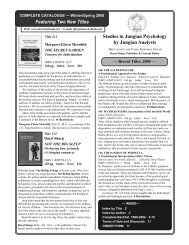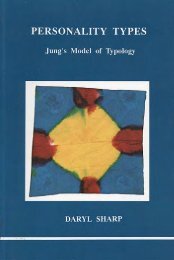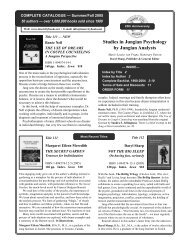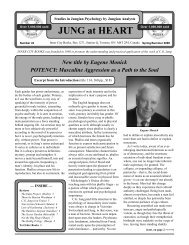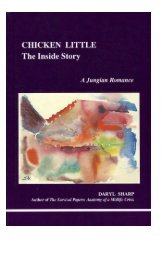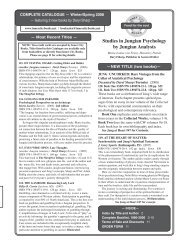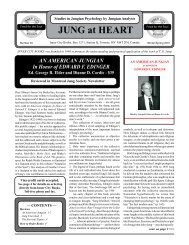Digesting Jung: Food for the Journey - Inner City Books
Digesting Jung: Food for the Journey - Inner City Books
Digesting Jung: Food for the Journey - Inner City Books
Create successful ePaper yourself
Turn your PDF publications into a flip-book with our unique Google optimized e-Paper software.
Dream On 79<br />
tively and <strong>the</strong>re<strong>for</strong>e less likely to project his or her own psychology<br />
onto <strong>the</strong>ir images. Of course, even some knowledge of one’s own<br />
complexes is no guarantee against projection, but without training<br />
of some kind both parties are whistling in <strong>the</strong> dark.<br />
The first step in working with dreams is to get <strong>the</strong> dreamer’s personal<br />
associations to all <strong>the</strong> images in it. If <strong>the</strong>re is a tree, say, or a<br />
rug or a snake or apple, it is important to determine what <strong>the</strong>se<br />
mean in <strong>the</strong> experience of <strong>the</strong> dreamer. This takes <strong>the</strong> <strong>for</strong>m of circumambulating<br />
<strong>the</strong> image, which means staying close to it: “What<br />
does an elephant mean to you?” . . . “What else?” . . . “And what<br />
else?” This is quite different from <strong>the</strong> traditional Freudian method<br />
of free association, which may eventually get to <strong>the</strong> complex but<br />
misses <strong>the</strong> significance of <strong>the</strong> image.<br />
On top of personal associations to dream images <strong>the</strong>re are often<br />
relevant amplifications—what trees or rugs or snakes or apples<br />
have meant to o<strong>the</strong>r people in o<strong>the</strong>r cultures at o<strong>the</strong>r times. A<br />
knowledge of archetypal images and motifs serves to broaden conscious<br />
awareness by bringing in material that is not personally<br />
known but is present in <strong>the</strong> unconscious as part of everyone’s psychic<br />
heritage.<br />
Garnering personal and archetypal associations to a dream, and<br />
its context in <strong>the</strong> dreamer’s waking life, is a relatively simple procedure.<br />
It is necessary, but only preparation <strong>for</strong> <strong>the</strong> real work—<strong>the</strong><br />
actual interpretation of <strong>the</strong> dream and what it is saying about <strong>the</strong><br />
dreamer’s conscious attitudes. This is an exacting task and an experience<br />
so intimate that <strong>the</strong> interpretation of any particular dream<br />
is really only valid <strong>for</strong> <strong>the</strong> two persons working on it.<br />
In general, dreams may be interpreted on a subjective or an objective<br />
level, and sometimes both are relevant. The <strong>for</strong>mer approach<br />
considers a dream strictly in terms of <strong>the</strong> dreamer’s own psychology.<br />
If a person I know appears in my dream, <strong>the</strong> focus is not on<br />
that actual person but on him or her as an image or symbol of projected<br />
unconscious contents. Where I have a vital connection with<br />
that person, however, an objective interpretation may be more to



